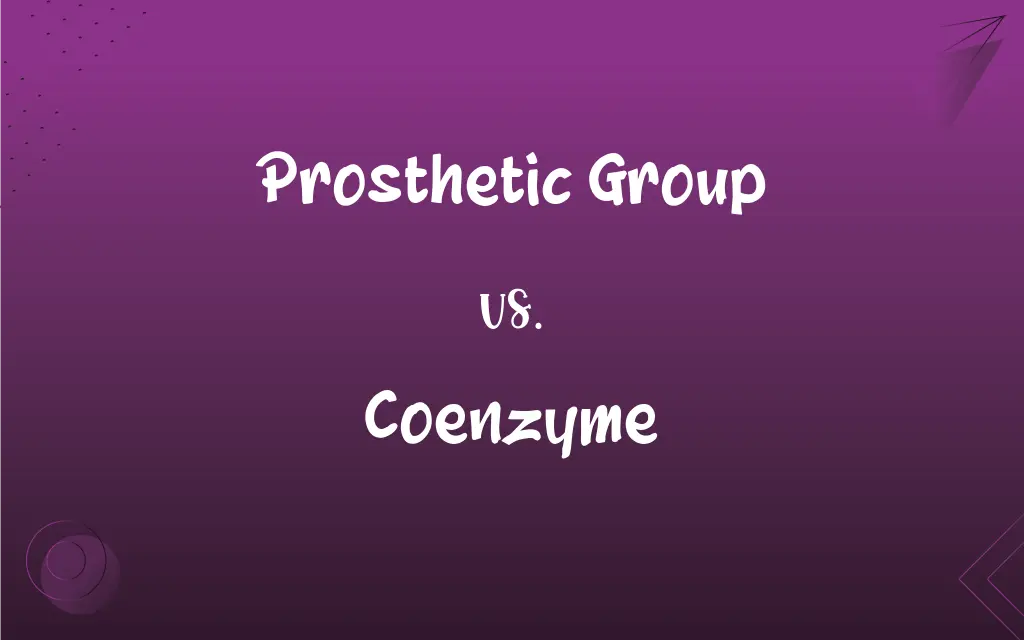Prosthetic Group vs. Coenzyme: What's the Difference?
Edited by Aimie Carlson || By Harlon Moss || Published on January 25, 2024
A prosthetic group is a non-protein molecule firmly attached to a protein, essential for its function, while a coenzyme is an organic non-protein compound that binds loosely to an enzyme to assist in a reaction.

Key Differences
Prosthetic groups are tightly bound to their enzyme, often permanently, and are essential for the enzyme's biological activity. Coenzymes, conversely, are loosely attached and can dissociate from the enzyme after the reaction.
The prosthetic group may be organic or metal ions, playing a critical role in the enzyme's structure and function. Coenzymes, primarily organic molecules like vitamins, aid enzymes in catalyzing reactions but are not part of the enzyme's structure.
Prosthetic groups are involved in a wide range of biological activities, including electron transport and substrate binding. Coenzymes act as carriers of groups or electrons between enzymes, facilitating various biochemical transformations.
Once attached, a prosthetic group remains with its enzyme throughout the enzyme's lifespan. Coenzymes can repeatedly attach and detach from different enzymes, acting as transient carriers.
Prosthetic groups, due to their permanent binding, often undergo changes during the enzyme's action, which are reverted back in the enzyme cycle. In contrast, coenzymes may change form during the reaction but are recycled back to their original state separately.
ADVERTISEMENT
Comparison Chart
Binding to Enzyme
Tightly, often permanently
Loosely, temporarily attached
Nature
Organic or metal ions
Organic molecules, often vitamin-derived
Role in Enzyme Activity
Integral to enzyme's structure and function
Assist in enzyme's catalytic activity
Involvement in Reactions
Remains with enzyme, changes during action
Transient, moves between different enzymes
Example
Heme in hemoglobin
NAD+ in dehydrogenase enzymes
ADVERTISEMENT
Prosthetic Group and Coenzyme Definitions
Prosthetic Group
Prosthetic groups include metal ions and organic compounds.
Zinc, a prosthetic group, is crucial for the activity of many enzymes.
Coenzyme
A coenzyme is an organic non-protein compound that assists enzymes in their catalytic activities.
NAD+ acts as a coenzyme in redox reactions by transferring electrons.
Prosthetic Group
It can be permanently attached to enzymes or other proteins.
The prosthetic group in cytochromes participates in electron transport.
Coenzyme
Many coenzymes are derived from vitamins and essential nutrients.
Vitamin B3 is a precursor for the coenzyme NAD+.
Prosthetic Group
Prosthetic groups can undergo reversible changes during enzyme reactions.
Flavin prosthetic groups in certain enzymes undergo redox reactions.
Coenzyme
They often act as carriers of chemical groups or electrons between enzymes.
FAD, a coenzyme, is vital in the Krebs cycle for transferring protons and electrons.
Prosthetic Group
A prosthetic group is a non-protein molecule bound to a protein necessary for its function.
The heme group in hemoglobin is a prosthetic group essential for oxygen transport.
Coenzyme
Coenzymes are essential for the function of many enzymes but are not part of their structure.
Coenzyme Q10 plays a crucial role in the electron transport chain.
Prosthetic Group
They are involved in the protein's active site and assist in substrate binding.
The prosthetic group in carbonic anhydrase is vital for its catalytic action.
Coenzyme
Coenzymes are loosely bound and can detach from the enzyme post-reaction.
Coenzyme A transfers acyl groups in metabolic reactions.
Coenzyme
An organic substance that reversibly combines with a specific protein, the apoenzyme, and with a substrate to form an active enzyme system.
Coenzyme
(biochemistry) Any small molecule that is necessary for the functioning of an enzyme.
Coenzyme
A molecule that is essential for the activity of some enzymes; it may exist free in solution within a living organism, but functions by binding to an enzyme to assist in catalyzing a reaction. The molecule itself may be temporarily changed during the reaction, but is ultimately restored to its original form. Many vitamins function as coenzymes.
Coenzyme
A small molecule (not a protein but sometimes a vitamin) essential for the activity of some enzymes
FAQs
How does a prosthetic group differ from a coenzyme?
Unlike coenzymes, which are loosely bound and can dissociate from the enzyme, prosthetic groups are tightly bound and typically remain attached during the reaction.
What is a prosthetic group?
A prosthetic group is a non-protein molecule that is tightly and permanently attached to a protein and is essential for its function.
Are prosthetic groups reusable?
Yes, they are reusable and remain attached to the enzyme through multiple reaction cycles.
How are prosthetic groups attached to proteins?
They can be covalently bonded or attached through strong non-covalent interactions.
Are prosthetic groups found in all types of organisms?
Yes, they are found across a wide range of organisms, from bacteria to humans.
Can a prosthetic group be a metal ion?
Yes, some prosthetic groups are metal ions like iron in heme, which is part of hemoglobin.
Do all enzymes have prosthetic groups?
No, not all enzymes require prosthetic groups for their activity.
What is a coenzyme?
A coenzyme is an organic non-protein compound that binds to an enzyme and helps in its catalytic activity.
What's an example of a prosthetic group?
Heme in hemoglobin is a classic example.
Do prosthetic groups affect enzyme specificity?
Yes, they often play a critical role in determining the enzyme's substrate specificity.
How do coenzymes differ from prosthetic groups?
Coenzymes are loosely bound to enzymes and can dissociate after the reaction, unlike prosthetic groups.
How do coenzymes interact with enzymes?
They bind to the enzyme's active site, typically through non-covalent interactions.
Can a coenzyme be reused?
Yes, coenzymes can be reused after dissociating from the enzyme.
Do all enzymes require coenzymes?
No, not all enzymes require coenzymes for their function.
Can a protein have more than one prosthetic group?
Yes, some proteins have multiple prosthetic groups.
What's an example of a coenzyme?
NAD+ (Nicotinamide adenine dinucleotide) is a common coenzyme.
Can a coenzyme be a metal ion?
Generally, coenzymes are organic molecules, while metal ions are considered cofactors.
Do coenzymes participate in the enzyme's reaction?
Yes, they often participate directly in the chemical reaction, sometimes even as temporary carriers of atoms or functional groups.
Are vitamins related to coenzymes?
Yes, many coenzymes are derived from vitamins, such as niacin in NAD+.
Are coenzymes species-specific?
While the basic types of coenzymes are consistent across species, specific forms can vary.
About Author
Written by
Harlon MossHarlon is a seasoned quality moderator and accomplished content writer for Difference Wiki. An alumnus of the prestigious University of California, he earned his degree in Computer Science. Leveraging his academic background, Harlon brings a meticulous and informed perspective to his work, ensuring content accuracy and excellence.
Edited by
Aimie CarlsonAimie Carlson, holding a master's degree in English literature, is a fervent English language enthusiast. She lends her writing talents to Difference Wiki, a prominent website that specializes in comparisons, offering readers insightful analyses that both captivate and inform.






































































